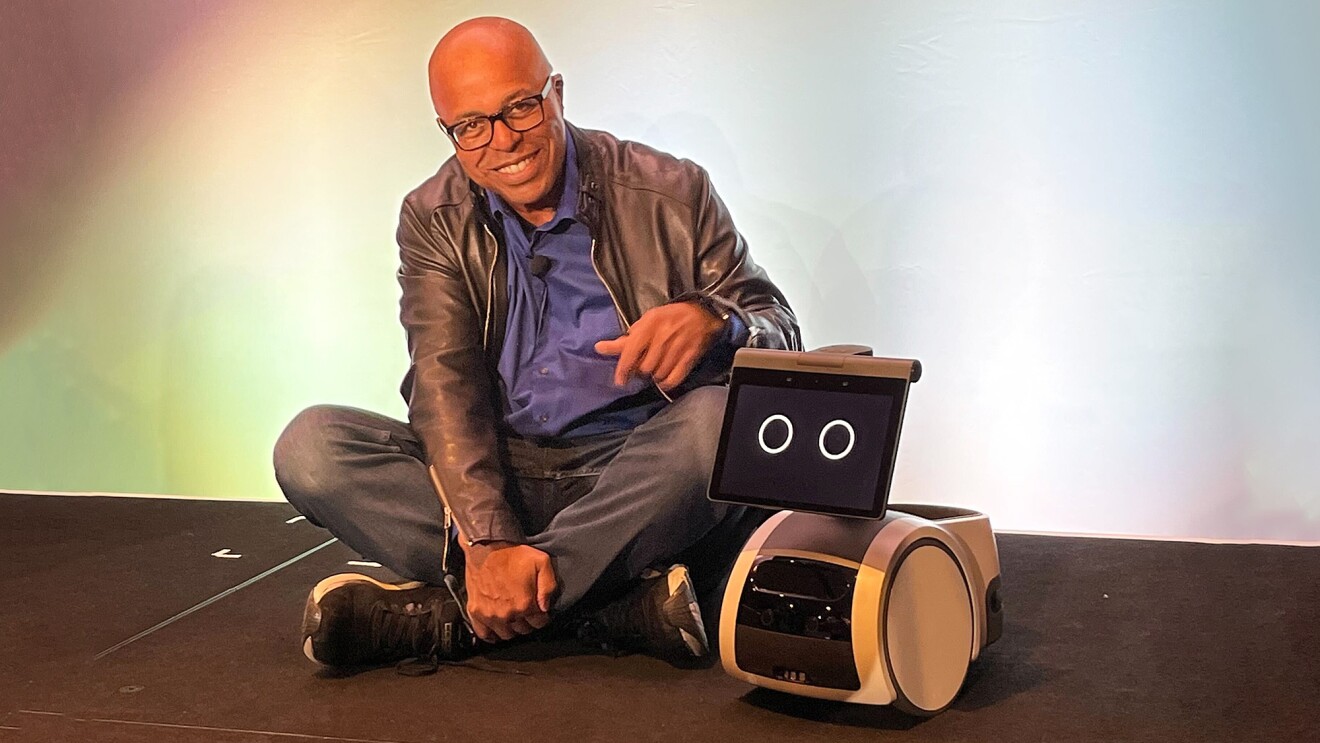You could say that Star Trek is the reason why Ken Washington works for Amazon.
Washington serves as vice president and general manager of consumer robotics at Amazon’s Devices & Services business, where he leads teams of engineers and scientists building smart robots. But he’s also one of the company’s foremost experts on ambient intelligence, the idea that digital systems, services, and devices, including robots, should work together in the background on our behalf. Ambient intelligence could help us create a world where technology can foresee many of our needs so we can focus on the things that really matter to us.
“What comes in the foreground is what it does for you,” Washington said. “People don’t care about computers; they care about what computers do for them. When you don't even know that those technologies are there and your days are just frictionless and magical, that’s our North Star.”

Speaking of stars, when you ask Washington to describe ambient intelligence, he might tell you about the Starship Enterprise, the iconic space vessel from his favorite television series. Or he might tell you about his house. But most likely, he’ll mention both.
Star struck
That’s because Washington’s ambient epiphany happened at home in 2016, when he purchased Amazon’s original Echo smart speaker, which comes with Alexa, the company’s voice AI. The fact that the inspiration for Alexa was the talking computer used by the Enterprise’s crew was not lost on the lifelong Trekkie. Intrigued by the technology, he quickly acquired and installed smart lights, door sensors, and other systems in his home, connecting them all through his Echo smart speaker. “I started building these scripts—a series of instructions—in my home so that when I walked into a room, lights would come on, when I left the room, lights would go off, when I turned on my stereo or my TV, the lights would dim,” he said. “Back then, that was really novel. It made my home feel like I was living on a Starship Enterprise.”
Next stop, Amazon
But Washington wanted others to experience this magic, too. “If I can do this, then I can work for a technology company like Amazon and make it easy for everybody to have it,” he said. “That’s why I am so passionate about ambient intelligence.”
That passion led him from his work on autonomous vehicles to Amazon’s Lab126 in Silicon Valley, home to many of the company’s research and development teams and the birthplace of Echo, the Kindle e-reader, and many other technologies that are now making the company’s ambient vision a reality.
The big picture

That vision was on display at Amazon’s Devices & Services 2022 Fall Launch, where Amazon announced a slew of new products and services, including Kindle Scribe, Halo Rise, and the Fire TV Omni QLED Series, among others. “Today, ambient intelligence comes to life across all of our devices and services, working behind the scenes on customers’ behalf, so they can focus on the here and now, and the people and experiences that matter most to them,” said Dave Limp, who runs Amazon Devices and Services.
The ambient inventions announced at the event are a strong indication that Amazon is on the right track, according to Bob O’Donnell, president, founder and chief analyst of TECHnalysis Research. “While new hardware devices and the discrete functions they support are always interesting, it’s not until the seamless connections between various devices start to enable a kind of thoughtful intelligence around us that things really start to get exciting,” he said. “The combination of useful services and positive experiences that make our lives a bit simpler and more rewarding are what the promise of ambient computing is all about.”
Limp said that, even though he didn’t have a name for it back then, Amazon’s ambient vision all started with Kindle. “When we launched Kindle 15 years ago, we set out to create a device so integrated with its service—in this case, reading—that the device itself disappeared,” he said. Inventions like the Echo and Alexa then brought our heads up, letting us use our voices to do everything from set timers to establish morning routines. These inventions were a launchpad for Amazon to build new categories of devices, including voice-powered Fire TVs, smart thermostats and even companions like Astro, the home robot Washington and his team launched last year.
Off to the races
The idea of the computer fading into the background is also the guiding principle for Heather Zorn. She joined Amazon 17 years ago, when it was merely the world’s largest bookstore, and is now vice president of Alexa. Zorn said she much prefers Star Wars to Washington’s beloved Star Trek. But while their sci-fi tastes may not be the same, Zorn also grasped Alexa’s importance early on, seeing the potential of ambient intelligence. “Alexa is really core to our journey around ambient intelligence,” said Zorn. “This is really about creating an intelligent AI that works on your behalf out of the box, so you don't have to have any specialized knowledge to get real value.”

For Zorn and her family, that value is apparent in a simplified morning rush. While Washington originally had to assemble his own smart home commands because the tech wasn’t yet available, customers can now create Alexa Routines with ease in the Alexa app. Zorn said she uses them every morning. One Routine allows her to automate tasks like getting her two boys up in the morning for school. Another dims the lights when the TV comes on and the family gathers to watch the latest episode of The Rings of Power. “I have to get everybody out of bed and out of the door on time in the morning,” Zorn said. “Alexa helps us do that in ways that just make every morning run more smoothly. We have smart lights by their beds that help wake them up. Alexa plays one of their favorite songs and we're off to the races.”
Smart thinking
The road to the ambient future includes another important feature called Hunches. Today, Alexa can have a Hunch that a device is not in its usual state and proactively take an action on your behalf. Hunches are powered by algorithms that leverage AI and machine learning to enable Alexa to anticipate everyday tasks. Zorn said that Amazon engineers designed Hunches to help create peace of mind for customers. “They can be super powerful,” she said. “If every night you turn off your kitchen light before bed at 10 p.m. and then one night you don't, Alexa can ask if you want the light off and, if you want, turn it off on your behalf moving forward.”
Amazon estimates that predictive and proactive features like Routines and Hunches help Alexa initiate more than 30% of smart home interactions without customers saying anything at all. And Alexa now initiates nearly 90% of daily Routines without a word from customers. Pair these numbers with the fact that there are now over 300 million smart home devices connected to Alexa, and the potential of ambient intelligence starts to emerge.
Earning Trust
Features enabled by Hunches, Routines, and other ambient technology are futuristic and cool, but Amazon executives like Limp, Washington, and Zorn understand that those features must also safeguard customers’ privacy. “Customer trust is paramount in everything we do,” Zorn said. That trust starts with the design process, making sure that every device has easy-to-use controls like physical shutters or buttons, simple in-app controls, or prompts within the device set-up experience. It includes data transparency and making sure that customers understand what information is being gathered, what it's being used for, and ultimately, that they have control of their data.
Adds Washington: “Trust is something you earn over time and that is very precious. We take this extremely seriously. Just like how we build up trust with people over time before inviting them into our homes, technology is no different.”
Famously, it’s always Day 1 at Amazon, and the same mentality applies to ambient intelligence. “We're very early in this journey, and it will take time,” Washington said. “But, as technology tends to do, ambient intelligence is only going to accelerate.”
Just like, perhaps, the Starship Enterprise. Warp Speed!
Trending news and stories











